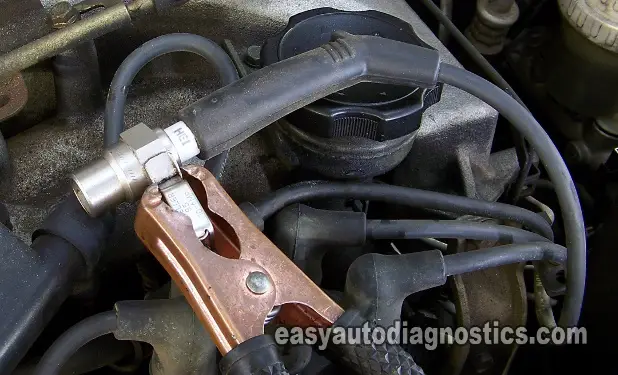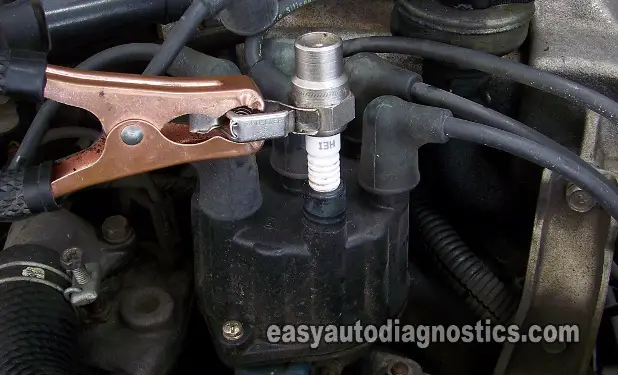TEST 1: Testing For Spark

The spark test is the most important test of all and will guide your diagnostic down the correct path. So then, here are some very important reminders to keep in mind: 1) do not use a regular spark plug in place of a spark tester for the spark test and 2) do not pull the spark plug wire off of the spark plug either while the engine is running (to check for spark).
Also, whether your Mitsubishi SUV (or Dodge pick up) does not start (cranks but does not start) or cranks and starts but runs with a misfire, I recommend that you test all spark plug wires for spark.
OK, let's start:
- 1
Remove the spark plug wire from its spark plug.
- 2
Attach the HEI spark tester to the spark plug wire.
Don't have an HEI spark tester? Need to buy one? You can buy it here: OTC 6589 Electronic Ignition Spark Tester. - 3
Connect the HEI spark tester to the battery negative (-) terminal with a battery jump start cable.
- 4
Have your helper crank the engine while you observe the spark tester.
- 5
Repeat the test for all of the remaining spark plug wires.
Let's interpret your test result:
CASE 1: You got spark on all of the spark plug wires. This is the correct test result and indicates that the spark plug wires, distributor cap and rotor, crankshaft position sensor (within the distributor), and ignition coil are working correctly.
If you're troubleshooting a no-start problem, you have eliminated these ignition system components as the cause of your vehicle's no-start condition.
If you're troubleshooting a misfire problem and need some suggestions as to what could be causing the misfire on your Chrysler car or mini-van, go to: Other Common Causes Of A Misfire.
CASE 2: You got NO spark on none of the spark plug wires. This test result tells you that a lack of spark is keeping the vehicle from starting.
But it doesn't condemn any specific component just yet. The next step is to check that the distributor cap is getting spark from the ignition coil. For this test go to: TEST 3: Ignition Coil High Tension Wire Spark Test.
CASE 3: You got spark on some but not all of the spark plug wires. More than likely the spark plug wires are bad or the distributor cap is bad.
It's a common problem for one or two spark plug wires to go bad or for one or two distributor cap towers to go bad and not let spark thru'. 90% of the time, replacing the distributor cap, the distributor rotor and the spark plug wires should solve your problem, BUT to further test this, go to: TEST 2: Testing For Spark At The Distributor Cap.
TEST 2: Testing For Spark At The Distributor Cap

Distributor caps do go bad and the cool thing is that they can be tested with a simple spark test.
Remember, that this test is only for when one or several (but not all) of the spark plug wires did not spark in TEST 1!
Let's get started:
- 1
Remove the spark plug wire (high tension wire) that DID NOT spark from its tower on the distributor cap.
- 2
Place the spark tester directly on the tower (see photo).
- 3
Connect the spark tester to the battery negative (-) terminal with a battery jump start cable.
The battery jump start cable will also aid you in holding the spark tester in place on the distributor cap. - 4
Have your assistant crank the engine while you observe the spark tester.
- 5
The spark tester should spark as your helper cranks the engine.
- 6
Repeat this test with the others that did not fire off spark (if applicable).
Let's analyze your test results:
CASE 1: The spark tester sparked. This is the correct test result.
With this test result you can conclude that the spark plug wire that connects to the tower is bad, replace them all. This is probably as far as you may need to go since your Mitsubishi or Dodge vehicle will probably start and run without a misfire problem after replacing these parts.
Here's why: As the spark plug wire ages, its normal resistance to spark increases to the point that the wire can not and does not transmit the spark to the spark plug. This will either cause a misfire, or a lack of power, or a no-start condition. Spark plug wires don't last forever, especially after-market ones (average life-span is 3 to 4 years).
CASE 2: The spark tester DID NOT spark. This test result tells you that the distributor cap is bad.
Replace the distributor cap and distributor rotor as a set. This should solve your misfire problem.
If the spark plug wires and spark plugs are as old as the distributor cap and rotor, I would recommend that you replace them all.
Here's why: As the distributor cap ages, the terminals that transmit the spark to the spark plug wires corrode. This corrosion increases the resistance to spark and over time (as more corrosion is created) this same corrosion stops the spark from passing thru' to the spark plug wires.
TEST 3: Ignition Coil High Tension Wire Spark Test

So far, your spark test results (from TEST 1) confirm that none of the spark plug wires are firing off spark.
The next step is to test for spark directly on the ignition coil's high tension wire.
This test will let you know if the spark plug wire (high tension wire) that feeds spark from the ignition coil to the distributor is bad or if you need to continue on to TEST 4.
Let's get testing:
- 1
Disconnect the ignition coil's high tension wire from the center of the distributor cap, but leave its other end connected to the ignition coil (see the photo above).
- 2
Attach the HEI spark tester to this wire.
NOTE: Make sure that the metal terminal that fits into the distributor cap tower (and that is now exposed) does not come in close proximity to any metal part of the engine or the spark will arch to Ground (at this point) instead of jumping across the HEI spark tester's air gap. - 4
Connect the HEI spark tester to the battery negative (-) terminal with a battery jump start cable.
- 5
Ask your helper to crank the engine once again while you observe the spark tester.
- 6
The spark tester should spark.
Let's analyze your spark test result:
CASE 1: You got spark. This is the correct and expected test result.
This test result confirms that spark is being delivered to the distributor but that the distributor cap is unable to distribute the spark to the spark plug wires.
Also, this test confirms that the ignition coil is GOOD. Replace the distributor cap and rotor as a set and retest (or crank up the vehicle). This should solve your no-start condition.
CASE 2: You got NO spark. Then further testing is required to see if the problem is due to a bad ignition coil, bad crankshaft position sensor, or something else.
The next test is to check for spark directly on ignition coil's tower. For this test go to: TEST 4: Ignition Coil Spark Test.

